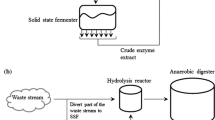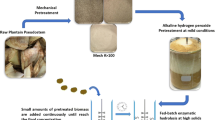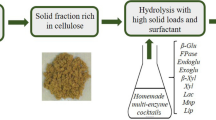Abstract
Continuous bio-production of succinic acid was reported in homogeneous solid dispersion (HSD) system utilizing porous coconut shell activated carbon (CSAC) as immobilization carrier. The aim of the present work was to implement the HSD system to increase the area of cell immobilization and the rate of succinic-acid production from the lignocellulosic medium. The ratio of the two enzymes (cellulase-to-hemicellulase) was initially optimized to break down the lignocellulose into its free monomers, wherein the best ratio was determined as 4:1. Succinic-acid production was evaluated in the HSD system by varying the substrate loading and dilution rate. The results showed that high productivities of succinic acid were obtained when 60 g/L glucose was fed over a dilution rates ranging from 0.03 to 0.4/h. The titer of succinic acid decreased gradually with higher dilution rate, whereas the residual substrate concentration increased with it. Critical dilution rate was determined to be 0.4/h at which the best productivity of succinic acid of 6.58 g/L h and its yield of 0.66 g/g were achieved using oil palm fronds (OPF) hydrolysate. This work lends evidence to the use of CSAC and lignocellulosic hydrolysate to further exploit the potential economies of scale.








Similar content being viewed by others
References
Morales M, Pielhop T, Saliba P, Hungerbühler K, Rudolf von Rohr P, Papadokonstantakis S (2017) Sustainability assessment of glucose production technologies from highly recalcitrant softwood including scavengers. Biofuels Bioprod Biorefin 11(3):441–453
Cao Y, Zhang R, Sun C, Cheng T, Liu Y, Xian M (2013) Fermentative succinate production: an emerging technology to replace the traditional petrochemical processes. BioMed Res Int 2013:12
Luthfi AAI, Manaf SFA, Illias RM, Harun S, Mohammad AW, Jahim JM (2017) Biotechnological route for sustainable succinate production utilizing oil palm frond and kenaf as potential carbon sources. Appl Microbiol Biotechnol 101(8):3055–3075
Scholten E, Renz T, Thomas J (2009) Continuous cultivation approach for fermentative succinic acid production from crude glycerol by Basfia succiniciproducens DD1. Biotechnol Lett 31(12):1947–1951
Nghiem NP, Kleff S, Schwegmann S (2017) Succinic acid: technology development and commercialization. Fermentation 3(2):26
Kim DY, Yim SC, Lee PC, Lee WG, Lee SY, Chang HN (2004) Batch and continuous fermentation of succinic acid from wood hydrolysate by Mannheimia succiniciproducens MBEL55E. Enzyme Microb Technol 35(6):648–653
Akhtar J, Idris A (2017) Oil palm empty fruit bunches a promising substrate for succinic acid production via simultaneous saccharification and fermentation. Renew Energy 114:917–923
Salvachúa D, Smith H, St. John PC, Mohagheghi A, Peterson DJ, Black BA, Dowe N, Beckham GT (2016) Succinic acid production from lignocellulosic hydrolysate by Basfia succiniciproducens. Bioresour Technol 214:558–566
Borges ER, Pereira N (2011) Succinic acid production from sugarcane bagasse hemicellulose hydrolysate by Actinobacillus succinogenes. J Ind Microbiol Biotechnol 38:1001–1011
Luthfi AAI, Jahim JM, Harun S, Tan JP, Mohammad AW (2016) Biorefinery approach towards greener succinic acid production from oil palm frond bagasse. Process Biochem 51(10):1527–1537
Sabiha-Hanim S, Noor MAM, Rosma A (2011) Effect of autohydrolysis and enzymatic treatment on oil palm (Elaeis guineensis Jacq.) frond fibres for xylose and xylooligosaccharides production. Bioresour Technol 102(2):1234–1239
McKinlay JB, Vieille C, Zeikus JG (2007) Prospects for a bio-based succinate industry. Appl Microbiol Biotechnol 76:727–740
Bradfield MFA, Mohagheghi A, Salvachúa D, Smith H, Black BA, Dowe N, Beckham GT, Nicol W (2015) Continuous succinic acid production by Actinobacillus succinogenes on xylose-enriched hydrolysate. Biotechnol Biofuels 8:181
Van Heerden CD, Nicol W (2013) Continuous succinic acid fermentation by Actinobacillus succinogenes. Biochem Eng J 73:5–11
Brink H, Nicol W (2014) Succinic acid production with Actinobacillus succinogenes: rate and yield analysis of chemostat and biofilm cultures. Microb Cell Fact 13:111
Maharaj K, Bradfield MFA, Nicol W (2014) Succinic acid-producing biofilms of Actinobacillus succinogenes: reproducibility, stability and productivity. Appl Microbiol Biotechnol 98(17):7379–7386
Villadsen J, Nielsen J, Lidn G (2011) Bioreaction Engineering principles. Springer Sciences and Business Media, Massachusetts, pp 383–458
Corona-González RI, Miramontes-Murillo R, Arriola-Guevara E, Guatemala-Morales G, Toriz G, Pelayo-Ortiz C (2014) Immobilization of Actinobacillus succinogenes by adhesion or entrapment for the production of succinic acid. Bioresour Technol 164:113–118
Alexandri M, Papapostolou H, Stragier L, Verstraete W, Papanikolaou S, Koutinas AA (2017) Succinic acid production by immobilized cultures using spent sulphite liquor as fermentation medium. Bioresour Technol 238:214–222
Luthfi AAI, Jahim JM, Harun S, Tan JP, Mohammad AW (2017) Potential use of coconut shell activated carbon as an immobilisation carrier for high conversion of succinic acid from oil palm frond hydrolysate. RSC Adv 7(78):49480–49489
Chen PC, Zheng P, Ye XY, Ji F (2017) Preparation of A. succinogenes immobilized microfiber membrane for repeated production of succinic acid. Enzyme Microb Technol 98:34–42
Shi X, Chen Y, Ren H, Liu D, Zhao T, Zhao N, Ying H (2014) Economically enhanced succinic acid fermentation from cassava bagasse hydrolysate using Corynebacterium glutamicum immobilized in porous polyurethane filler. Bioresour Technol 174:190–197
Zhu Y (2007) Chap. 14—immobilized cell fermentation for production of chemicals and fuels A2—Yang, Shang-Tian. In: Bioprocessing for value-added products from renewable resources. Elsevier, Amsterdam, pp 373–396
Manaf SFA, Jahim JM, Harun S, Luthfi AAI (2018) Fractionation of oil palm fronds (OPF) hemicellulose using dilute nitric acid for fermentative production of xylitol. Ind Crop Prod 115:6–15
Hames BR (2009) Biomass compositional analysis for energy application. In: Mielenz JR (ed) Biofuels: methods and protocols. Humana Press, California, pp 145–167
Sluiter A, Hames B, Ruiz R, Scarlata C, Sluiter J, Templeton D, Crocker D (2008) Determination of structural carbohydrates and lignin in biomass. NREL Laboratory Analytical Procedures (LAP), National Renewable Energy Laboratory, Golden
Ghose TK (1987) Measurement of cellulase activities. Pure Appl Chem 59:257–268
Bailey MJ, Biely P, Poutanen K (1992) Interlaboratory testing of methods for assay of xylanase activity. J Biotechnol 23:257–270
Harun S, Balan V, Takriff MS, Hassan O, Jahim J, Dale BE (2013) Performance of AFEX™ pretreated rice straw as source of fermentable sugars: the influence of particle size. Biotechnol Biofuels 6(1):1–17
Telliard W (2001) Method 1684: total, fixed, and volatile solids in water, solids, and biosolids. US Environmental Protection Agency, Washington
Rezende CA, de Lima MA, Maziero P, deAzevedo ER, Garcia W, Polikarpov I (2011) Chemical and morphological characterization of sugarcane bagasse submitted to a delignification process for enhanced enzymatic digestibility. Biotechnol Biofuels 4:54–54
Anwar Z, Gulfraz M, Irshad M (2014) Agro-industrial lignocellulosic biomass a key to unlock the future bio-energy: a brief review. J Radiat Res Appl Sci 7(2):163–173
Hsu T-C, Guo G-L, Chen W-H, Hwang W-S (2010) Effect of dilute acid pretreatment of rice straw on structural properties and enzymatic hydrolysis. Bioresour Technol 101(13):4907–4913
Pu Y, Hu F, Huang F, Davison BH, Ragauskas AJ (2013) Assessing the molecular structure basis for biomass recalcitrance during dilute acid and hydrothermal pretreatments. Biotechnol Biofuels 6(1):15
Zakaria MR, Hirata S, Hassan MA (2015) Hydrothermal pretreatment enhanced enzymatic hydrolysis and glucose production from oil palm biomass. Bioresour Technol 176:142–148
Sabiha-Hanim S, Noor MAM, Rosma A (2015) Fractionation of oil palm frond hemicelluloses by water or alkaline impregnation and steam explosion. Carbohydr Polym 115:533–539
Lai L-W, Idris A (2013) Disruption of oil palm trunks and fronds by microwave-alkali pretreatment. BioResources 8(2):2792–2804
Hussin MH, Rahim AA, Ibrahim MNM, Yemloul M, Perrin D, Brosse N (2014) Investigation on the structure and antioxidant properties of modified lignin obtained by different combinative processes of oil palm fronds (OPF) biomass. Ind Crop Prod 52:544–551
Fang C, Thomsen MH, Brudecki GP, Cybulska I, Frankær CG, Bastidas-Oyanedel JR, Schmidt JE (2015) Seawater as alternative to freshwater in pretreatment of date palm residues for bioethanol production in coastal and/or arid areas. ChemSusChem 8(22):3823–3831
Xu J, Zhang X, Cheng JJ (2012) Pretreatment of corn stover for sugar production with switchgrass-derived black liquor. Bioresour Technol 111:255–260
Budi E, Nasbey H, Yuniarti B, Nurmayatri Y, Fahdiana J, Budi A (2014) Pore structure of the activated coconut shell charcoal carbon. In: AIP Conference proceedings, vol 1. AIP, pp 130–133
Guettler MV, Rumler D, Jain MK (1999) Actinobacillus succinogenes sp. nov., a novel succinic-acid-producing strain from the bovine rumen. Int J Syst 49:207–216
McKinlay JB, Shachar-Hill Y, Zeikus JG, Vieille C (2007) Determining Actinobacillus succinogenes metabolic pathways and fluxes by NMR and GC-MS analyses of 13C-labeled metabolic product isotopomers. Metab Engin 9:177–192
Pörtner R (2015) Bioreactors for mammalian cells. In: Al-Rubeai M (ed) Animal cell culture. Springer International Publishing, Switzerland, pp 89–135
Corona-González RI, Bories A, González-Álvarez V, Pelayo-Ortiz C (2008) Kinetic study of succinic acid production by Actinobacillus succinogenes ZT-130. Process Biochem 43:1047–1053
Lee PC, Lee SY, Hong SH, Chang HN (2003) Batch and continuous cultures of Mannheimia succiniciproducens MBEL55E for the production of succinic acid from whey and corn steep liquor. Bioprocess Biosyst Eng 26(1):63–67
Acknowledgements
The authors acknowledge the financial support by the Ministry of Higher Education, Malaysia through the grant provided under Long term Research Grant Scheme (LRGS/2013/UKM-UKM/PT/01) on project entitled “Biochemical Platform for Conversion of Diversified Lignocellulosic Biomass to Priceless Precursor and Biobased Fine Chemicals”.
Author information
Authors and Affiliations
Corresponding author
Rights and permissions
About this article
Cite this article
Luthfi, A.A.I., Tan, J.P., Harun, S. et al. Homogeneous solid dispersion (HSD) system for rapid and stable production of succinic acid from lignocellulosic hydrolysate. Bioprocess Biosyst Eng 42, 117–130 (2019). https://doi.org/10.1007/s00449-018-2019-8
Received:
Accepted:
Published:
Issue Date:
DOI: https://doi.org/10.1007/s00449-018-2019-8




